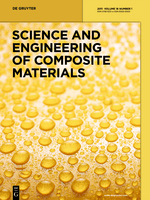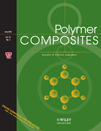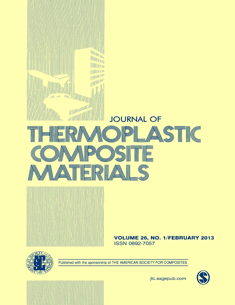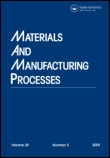
SCIENCE AND ENGINEERING OF COMPOSITE MATERIALS
Scope & Guideline
Elevating Knowledge in Ceramics and Composites
Introduction
Aims and Scopes
- Composite Material Development:
Research on the synthesis, processing, and enhancement of composite materials, focusing on their mechanical, thermal, and electrical properties. - Durability and Performance Analysis:
Studies examining the durability, longevity, and performance of composite materials under various environmental conditions and mechanical stresses. - Innovative Applications:
Exploration of new and innovative applications of composite materials across different industries, including aerospace, civil engineering, and automotive sectors. - Modeling and Simulation:
Utilization of advanced numerical methods and simulations to predict the behavior of composite materials under different loading and environmental conditions. - Sustainability in Composite Materials:
Research focused on the sustainability aspects of composite materials, including recycling, use of bio-based materials, and reducing environmental impact.
Trending and Emerging
- Nanocomposites and Advanced Materials:
A surge in research focusing on nanocomposites, particularly those incorporating nanoparticles and nanofibers, is evident. These materials are being explored for their superior mechanical and thermal properties. - Smart and Functional Composites:
The development of smart composites that can respond to environmental stimuli is gaining interest. This includes materials with self-healing capabilities and those integrating sensors for real-time monitoring. - Sustainability and Eco-Friendly Composites:
Research on sustainable materials is on the rise, with an emphasis on using biodegradable and recycled components, as well as studies aimed at reducing the carbon footprint of composite production. - Multiscale Modeling Approaches:
There is an increasing trend towards multiscale modeling techniques that integrate various scales of material behavior, allowing for more accurate predictions of composite performance. - Hybrid and Multimaterial Composites:
The exploration of hybrid composites that combine different types of materials is becoming more prevalent, particularly in applications requiring tailored properties for specific engineering challenges.
Declining or Waning
- Traditional Composite Reinforcement Techniques:
There has been a noticeable decline in studies focusing on conventional reinforcement techniques, such as the use of glass and carbon fibers, as researchers explore more advanced and hybrid materials. - Basic Mechanical Testing:
Research centered solely on basic mechanical properties testing is becoming less prominent, with a shift towards more comprehensive studies that incorporate multi-faceted performance evaluations. - Conventional Concrete Composites:
The focus on traditional concrete composites has decreased as researchers are increasingly investigating high-performance and sustainable alternatives, such as those incorporating recycled materials. - Static Load Testing:
Static load testing studies are being overshadowed by dynamic and fatigue testing research, reflecting a growing interest in understanding the behavior of materials under real-world conditions.
Similar Journals

POLYMER COMPOSITES
Elevating Knowledge in Polymer SciencePOLYMER COMPOSITES, published by WILEY, is a leading journal dedicated to advancing the fields of materials science and engineering through the exploration of polymer composite materials. With its foundation dating back to 1980, this esteemed journal has continuously provided a platform for researchers to publish high-quality studies and innovative methodologies in areas such as ceramics, composites, and miscellaneous chemistry. Ranked in the prestigious Q1 quartile for sectors like Polymers and Plastics as well as Materials Chemistry, POLYMER COMPOSITES stands significant within the academic community, holding a notable impact factor that reflects its influence. The journal encompasses a comprehensive range of topics, making it essential reading for professionals, researchers, and students aiming to stay at the forefront of developments in polymer science and composite technologies. Although it does not currently offer Open Access, readers can access its impactful publications through institutional or individual subscriptions, contributing to ongoing advancements in the field and facilitating the exchange of valuable knowledge among scientists and engineers worldwide.

Materia-Rio de Janeiro
Fostering collaboration for impactful scientific discoveries.Materia-Rio de Janeiro is a distinguished open-access journal published by UNIV FED RIO DE JANEIRO, LAB HIDROGENIO, dedicated to advancing knowledge in the fields of Chemistry, Materials Science, and Physics. Since its inception in 2006, the journal has established a platform for the dissemination of innovative research, fostering collaboration among researchers globally. The journal's commitment to open access promotes the widespread availability of valuable scientific findings, making it an essential resource for academia and industry professionals alike. With a focus on diverse disciplines, Materia-Rio de Janeiro holds a Q4 classification in multiple categories for 2023, indicating its relevance in the expansive landscape of materials research. Operating from Rio de Janeiro, Brazil, this journal serves as a vital conduit for emerging scientific insights, hence delivering impactful contributions to the global research community.

AIMS Materials Science
Illuminating the Path of Materials InnovationAIMS Materials Science is an esteemed open-access journal dedicated to advancing the field of materials science. Published by the American Institute of Mathematical Sciences (AIMS), this journal has been a vital resource for researchers, professionals, and students since its inception in 2014. With an ISSN of 2372-0468 and an E-ISSN of 2372-0484, it focuses on disseminating high-quality research in materials science, ranging from general materials science to cutting-edge advancements in innovative materials applications. Currently ranked Q3 in the 2023 Scopus Materials Science (miscellaneous) category, with a ranking of 253/463, AIMS Materials Science strives to provide an open forum for scholarly dialogue and collaboration, ensuring valuable insights are accessible to the global scientific community. The journal's commitment to open access enhances its visibility and reach, further promoting impactful research in this dynamic field.

Inorganic Materials-Applied Research
Unlocking Potential in Inorganic Materials ScienceInorganic Materials-Applied Research is a pivotal journal dedicated to the dissemination of innovative research in the field of inorganic materials. Published by SpringerNature, this journal operates as a vital resource for researchers, professionals, and students alike, providing a platform for cutting-edge findings and methodologies related to the synthesis, characterization, and application of inorganic materials. With an ISSN of 2075-1133 and an E-ISSN of 2075-115X, the journal strives to bridge gaps in interdisciplinary studies, fostering collaboration across the engineering and materials science domains. Despite its current rankings placing it in the Q3 quartile for both Engineering and Materials Science categories, the journal aims for broader impact, seeking to enhance its visibility and contribution in publications through rigorous peer-review and open access options. Converged from 2010 to 2024, it remains committed to advancing knowledge and addressing contemporary challenges in materials science, thereby attracting contributions that are not only academically rigorous but also socially impactful.

Composites Research
Pioneering Insights in Composite Materials ScienceComposites Research is an esteemed academic journal dedicated to advancing the field of composite materials, published by the Korean Society of Composite Materials. With a focus on innovative research and development, this journal serves as a vital platform for researchers, professionals, and scholars in the field, promoting high-quality papers that discuss both theoretical and practical aspects of composite materials. Although it operates under a traditional access model, the journal remains committed to disseminating essential knowledge and cutting-edge findings relevant to the latest trends and technological advancements in composites. The ISSN 2288-2103 and E-ISSN 2288-2111 ensure the widespread visibility and accessibility of published works. The journal is strategically positioned to contribute to the growing body of knowledge in composite research, enabling the exchange of ideas and collaboration among a global audience.

JOURNAL OF THERMOPLASTIC COMPOSITE MATERIALS
Advancing the Future of Thermoplastic CompositesJOURNAL OF THERMOPLASTIC COMPOSITE MATERIALS, published by SAGE PUBLICATIONS LTD, is a cutting-edge journal dedicated to advancing the field of thermoplastic composites and their applications within ceramics and condensed matter physics. With an ISSN of 0892-7057 and an E-ISSN of 1530-7980, the journal boasts a strong academic reputation evidenced by its impressive impact factor as well as its classification in the 2023 Q2 category for both Ceramics and Composites and Condensed Matter Physics. Ranked #60 in Condensed Matter Physics and #26 in Materials Science by Scopus, the journal plays a pivotal role in disseminating innovative research findings, trends, and advancements to a global audience. Spanning research from 1988 to 2024, it serves as an essential resource for researchers, professionals, and students alike, fostering collaboration and promoting knowledge in the ever-evolving landscape of thermoplastic composite materials. Although currently not open access, the comprehensive content and critical insights provided by this journal are invaluable for those engaged in cutting-edge research and practical applications in these fields.

Journal of Metals Materials and Minerals
Catalyzing Discoveries in Metals, Ceramics, and BiomaterialsJournal of Metals Materials and Minerals (ISSN: 0857-6149) is a renowned academic publication dedicated to the interdisciplinary fields of metallurgical science, materials engineering, and mineralogy. Published by Chulalongkorn University, Metallurgy & Materials Science Research Institute in Thailand, this journal serves as a pivotal platform for researchers to disseminate their findings and explore innovative applications related to metals, ceramics, polymers, and biomaterials. Although the journal does not currently adopt an open-access model, it provides insightful content that facilitates knowledge sharing among professionals and academics alike. The journal has established its credibility with impressive Scopus ranking percentiles, particularly in categories such as Metals and Alloys and Ceramics and Composites. With an emphasis on advancing the understanding of materials science from 2017 to 2024, the Journal of Metals Materials and Minerals remains an essential resource for those striving to contribute to and stay informed about the latest trends and breakthroughs in these dynamic fields.

Composites Theory and Practice
Innovating Through Materials Science and EngineeringComposites Theory and Practice is an esteemed academic journal published by the Polish Society of Composite Materials, dedicated to the exploration and advancement of research in the fields of ceramics, composites, materials chemistry, mechanical engineering, and mechanics of materials. Commencing its publication in 2019, the journal aims to disseminate high-quality research findings that contribute to the theoretical and practical understanding of composite materials, which are pivotal for technological innovation. With an ISSN of 2084-6096 and an E-ISSN of 2299-128X, it provides robust scholarship recognized within the academic community, albeit currently categorized in the Q4 quartile rankings across multiple relevant fields. Researchers and professionals seeking a platform to share transformative insights related to composite materials will find Composites Theory and Practice a valuable resource for advancing knowledge and application in this critical area of study.

MATERIALS AND MANUFACTURING PROCESSES
Pioneering Research in Materials and Manufacturing Excellence.MATERIALS AND MANUFACTURING PROCESSES, published by Taylor & Francis Inc, is a leading journal dedicated to the dynamic fields of materials science and manufacturing engineering. Established in 1989, the journal has built a formidable reputation, exemplified by its prestigious Q1 rankings in 2023 across various categories, including Industrial and Manufacturing Engineering, Materials Science, Mechanical Engineering, and Mechanics of Materials. With a robust focus on innovative research and the latest advancements in manufacturing techniques and materials application, the journal serves as a vital resource for researchers, professionals, and students alike. The journal is indexed in renowned databases and boasts high impact factors, reflecting its influence in the academic community. Although it does not offer open access, it provides extensive platforms for disseminating crucial findings that push the boundaries of engineering and science. For those seeking impactful research contributions, MATERIALS AND MANUFACTURING PROCESSES remains at the forefront of fostering scholarly dialogue and advancing the field.

Elastomers and Composites
Shaping Tomorrow's Materials Through Rigorous ScholarshipElastomers and Composites is a leading academic journal dedicated to the advancement of knowledge in the fields of polymer science and materials engineering, specifically focusing on elastomers and composite materials. Published by RUBBER SOC KOREA, this journal serves as a vital platform for researchers and professionals to disseminate innovative research findings and insights in material properties, applications, and synthesis techniques. Although it currently does not offer open access, the journal provides rigorous peer-reviewed content that enhances the global dialogue on elastomeric materials and their composites, reflecting its commitment to high-quality scholarship. With a strong emphasis on practical relevance and theoretical advancements, Elastomers and Composites aspires to reshape industry practices and academic thought, making it an invaluable resource for students, researchers, and practitioners alike. Positioned strategically within its field, this journal fosters collaboration and dialogue among scientific communities, all while supporting the growth of cutting-edge research programs worldwide.